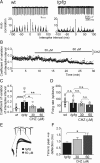KCa channels as therapeutic targets in episodic ataxia type-2
- PMID: 20505091
- PMCID: PMC2909841
- DOI: 10.1523/JNEUROSCI.6341-09.2010
KCa channels as therapeutic targets in episodic ataxia type-2
Abstract
Episodic ataxia type-2 (EA2) is an inherited movement disorder caused by mutations in the gene encoding the Ca(v)2.1alpha1 subunit of the P/Q-type voltage-gated calcium channel that result in an overall reduction in the P/Q-type calcium current. A consequence of these mutations is loss of precision of pacemaking in cerebellar Purkinje cells. This diminished precision reduces the information encoded by Purkinje cells and is thought to contribute to symptoms associated with this disorder. The loss of the precision of pacemaking in EA2 is the consequence of reduced activation of calcium-dependent potassium channels (K(Ca)) by the smaller calcium current and in vitro can be pharmacologically restored by K(Ca) activators. We used a well established mouse model of EA2, the tottering (tg/tg) mouse, to examine the potential therapeutic utility of one such Food and Drug Administration (FDA)-approved compound, chlorzoxazone (CHZ). Compared with wild-type Purkinje cells, we found the firing rate of tg/tg Purkinje cells in acutely prepared cerebellar slices to be very irregular. Bath application of CHZ successfully restored the precision of pacemaking in a dose-dependent manner. Oral administration of CHZ to tg/tg mice improved their baseline motor performance and reduced the severity, frequency, and duration of episodes of dyskinesia without producing any adverse effects. We propose the use of CHZ, which is currently FDA approved as a muscle relaxant, as a safe and novel treatment of EA2.
Figures




References
-
- Ahn CY, Kim EJ, Lee I, Kwon JW, Kim WB, Kim SG, Lee MG. Effects of glucose on the pharmacokinetics of intravenous chlorzoxazone in rats with acute renal failure induced by uranyl nitrate. J Pharm Sci. 2003;92:1604–1613. - PubMed
-
- Barclay J, Balaguero N, Mione M, Ackerman SL, Letts VA, Brodbeck J, Canti C, Meir A, Page KM, Kusumi K, Perez-Reyes E, Lander ES, Frankel WN, Gardiner RM, Dolphin AC, Rees M. Ducky mouse phenotype of epilepsy and ataxia is associated with mutations in the Cacna2d2 gene and decreased calcium channel current in cerebellar Purkinje cells. J Neurosci. 2001;21:6095–6104. - PMC - PubMed
-
- Bever CT, Jr, Young D, Anderson PA, Krumholz A, Conway K, Leslie J, Eddington N, Plaisance KI, Panitch HS, Dhib-Jalbut S. The effects of 4-aminopyridine in multiple sclerosis patients: results of a randomized, placebo-controlled, double-blind, concentration-controlled, crossover trial. Neurology. 1994;44:1054–1059. - PubMed
Publication types
MeSH terms
Substances
Grants and funding
LinkOut - more resources
Full Text Sources
Other Literature Sources
Molecular Biology Databases
Miscellaneous
